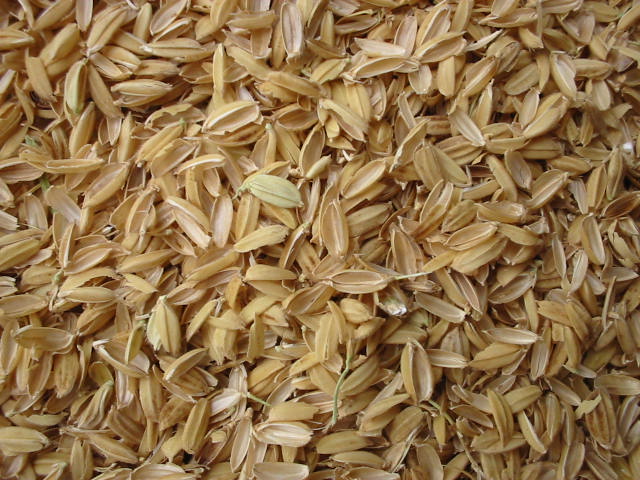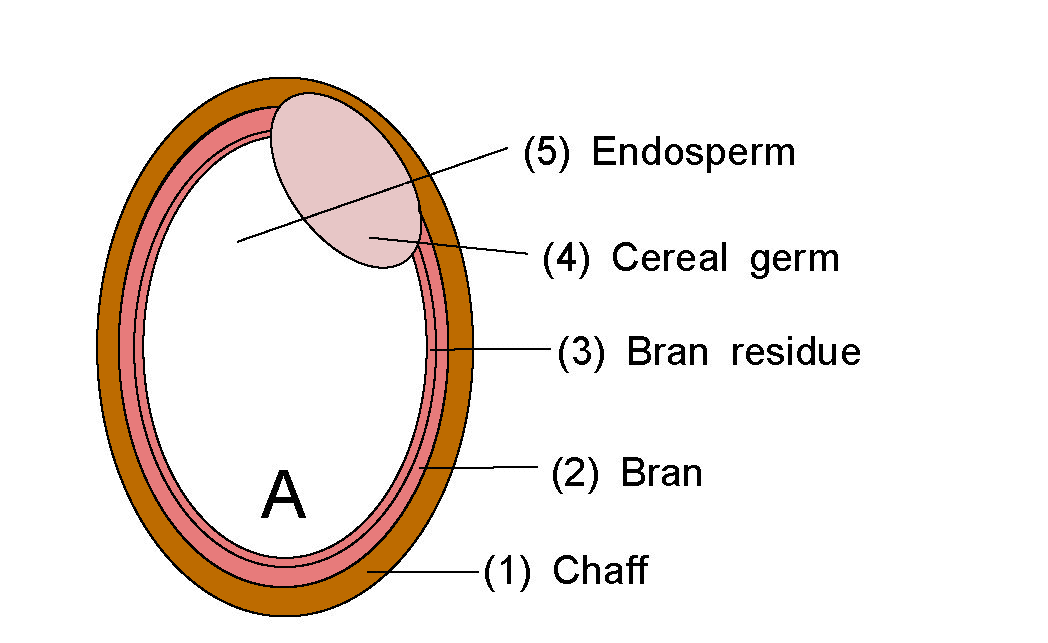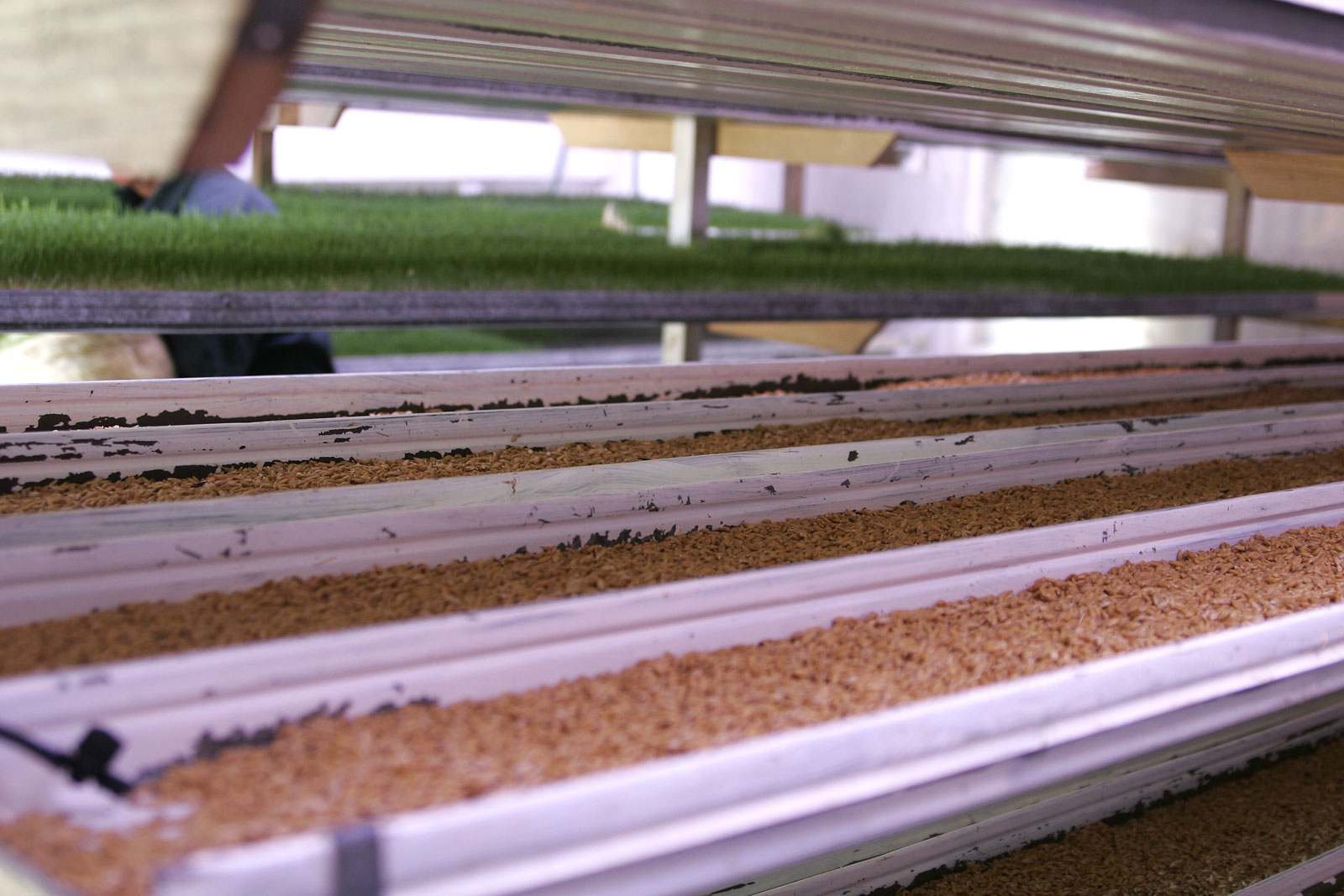|
Chaff
Chaff (; ) is dry, scale-like plant material such as the protective seed casings of cereal grains, the scale-like parts of flowers, or finely chopped straw. Chaff cannot be digested by humans, but it may be fed to livestock, ploughed into soil, or burned. Etymology "Chaff" comes from Middle English , from Old English , related to Old High German ', "husk". Grain chaff In grasses (including cereals such as rice, barley, oats, and wheat), the ripe seed is surrounded by thin, dry, scaly bracts (called glumes, lemmas, and paleas), forming a dry husk (or hull) around the grain. Once it is removed, it is often referred to as chaff. In wild cereals and in the primitive domesticated einkorn,Potts, D. T. (1996) ''Mesopotamia Civilization: The Material Foundations'' Cornell University Press. p. 62. . emmer and spelt wheats, the husks enclose each seed tightly. Before the grain can be used, the husks must be removed. The process of loosening the chaff from the grain so as to ... [...More Info...] [...Related Items...] OR: [Wikipedia] [Google] [Baidu] |
Chaff Cutter
A chaff cutter is a mechanical device for cutting straw or hay into small pieces before being mixed together with other forage and fed to horses and cattle. This aids the animal's digestion and prevents animals from rejecting any part of their food.Introduction tchaff cutterThe “chaff box” or “chaff cutter” Chaff and hay played a vital role in most agricultural production as it was used for feeding horses. Horses were extensively used in farming operations until they were replaced by tractors in the 1940s. Chaff cutters have evolved from the basic machines into commercial standard machines that can be driven at various speeds and can achieve various lengths of cuts of chaff with respect to animal preference type. New chaff cutter machines include portable tractor driven chaff cutter - where chaff cutter can be in the field and load trolleys (if required). References Agricultural machinery {{Agriculture-stub ... [...More Info...] [...Related Items...] OR: [Wikipedia] [Google] [Baidu] |
Rice
Rice is a cereal grain and in its Domestication, domesticated form is the staple food of over half of the world's population, particularly in Asia and Africa. Rice is the seed of the grass species ''Oryza sativa'' (Asian rice)—or, much less commonly, ''Oryza glaberrima'' (African rice). Asian rice was domesticated in China some 13,500 to 8,200 years ago; African rice was domesticated in Africa about 3,000 years ago. Rice has become commonplace in many cultures worldwide; in 2023, 800 million tons were produced, placing it third after sugarcane and maize. Only some 8% of rice is traded internationally. China, India, and Indonesia are the largest consumers of rice. A substantial amount of the rice produced in developing nations is lost after harvest through factors such as poor transport and storage. Rice yields can be reduced by pests including insects, rodents, and birds, as well as by weeds, and by List of rice diseases, diseases such as rice blast. Traditional rice polyc ... [...More Info...] [...Related Items...] OR: [Wikipedia] [Google] [Baidu] |
Bran
Bran, also known as miller's bran, is the component of a Cereal, cereal grain consisting of the hard layersthe combined aleurone and Fruit anatomy#Pericarp layers, pericarpsurrounding the endosperm. Maize, Corn (maize) bran also includes the pedicel (tip cap). Along with the cereal germ, germ, it is an integral part of whole grains, and is often produced as a byproduct of mill (grinding), milling in the production of refined grains. Bran is highly nutritious, but is difficult to digest due to its high fiber content; its high fat content also reduces its shelf life as the oils/fats are prone to becoming rancid. As such, it is typically removed from whole grain during the Refined grains, refining processe.g. in processing wheat grain into white flour, or refining brown rice into white rice. Bran is present in cereal grain, including rice, maize, corn (maize), wheat, oats, barley, rye, and millet. Bran is not the same as chaff, which is a coarser, scaly material surrounding the gr ... [...More Info...] [...Related Items...] OR: [Wikipedia] [Google] [Baidu] |
Rice Chaffs
Rice is a cereal grain and in its Domestication, domesticated form is the staple food of over half of the world's population, particularly in Asia and Africa. Rice is the seed of the grass species ''Oryza sativa'' (Asian rice)—or, much less commonly, ''Oryza glaberrima'' (African rice). Asian rice was domesticated in China some 13,500 to 8,200 years ago; African rice was domesticated in Africa about 3,000 years ago. Rice has become commonplace in many cultures worldwide; in 2023, 800 million tons were produced, placing it third after sugarcane and maize. Only some 8% of rice is traded internationally. China, India, and Indonesia are the largest consumers of rice. A substantial amount of the rice produced in developing nations is lost after harvest through factors such as poor transport and storage. Rice yields can be reduced by pests including insects, rodents, and birds, as well as by weeds, and by List of rice diseases, diseases such as rice blast. Traditional rice polyc ... [...More Info...] [...Related Items...] OR: [Wikipedia] [Google] [Baidu] |
Fodder
Fodder (), also called provender (), is any agriculture, agricultural foodstuff used specifically to feed domesticated livestock, such as cattle, domestic rabbit, rabbits, sheep, horses, chickens and pigs. "Fodder" refers particularly to food given to the animals (including plants cut and carried to them), rather than that which they forage for themselves (called forage). Fodder includes hay, straw, silage, compressed and Compound feed, pelleted feeds, oils and mixed rations, and sprouting, sprouted grains and legumes (such as bean sprouts, fresh malt, or brewing#Brewer's spent grain, spent malt). Most animal feed is from plants, but some manufacturers add ingredients to processed feeds that are of animal origin. The worldwide animal feed trade produced 1.245 billion tons of compound feed in 2022 according to an estimate by the International Feed Industry Federation, with an annual growth rate of about 2%. The use of agricultural land to grow feed rather than human food can be ... [...More Info...] [...Related Items...] OR: [Wikipedia] [Google] [Baidu] |
Einkorn
Einkorn wheat (from German ''Einkorn'', literally "single grain") can refer to either a wild species of wheat (''Triticum'') or a domesticated form of wheat. The wild form is ''T. boeoticum'' (syn. ''T. m.'' subsp. ''boeoticum''), and the domesticated form is ''T. monococcum'' (syn. ''T. m.'' subsp. ''monococcum''). Einkorn is a diploid species (2''n'' = 14 chromosomes) of hulled wheat, with tough glumes ( husks) that tightly enclose the grains. The cultivated form is similar to the wild, except that the ear stays intact when ripe and the seeds are larger. The domestic form is known as in French, in German, "einkorn" or "littlespelt" in English, in Italian and in Spanish. The name refers to the fact that each spikelet contains only one grain. Einkorn wheat was one of the first plants to be domesticated and cultivated. The earliest clear evidence of the domestication of einkorn dates from 10,600 to 9,900 years before present (8650 BCE to 7950 BCE) from Çayönü and Cafer ... [...More Info...] [...Related Items...] OR: [Wikipedia] [Google] [Baidu] |
Cereal Grain
A cereal is a grass cultivated for its edible grain. Cereals are the world's largest crops, and are therefore staple foods. They include rice, wheat, rye, oats, barley, millet, and maize (Corn). Edible grains from other plant families, such as amaranth, buckwheat and quinoa, are pseudocereals. Most cereals are annuals, producing one crop from each planting, though rice is sometimes grown as a perennial. Winter varieties are hardy enough to be planted in the autumn, becoming dormant in the winter, and harvested in spring or early summer; spring varieties are planted in spring and harvested in late summer. The term cereal is derived from the name of the Roman goddess of grain crops and fertility, Ceres. Cereals were domesticated in the Neolithic around 8,000 years ago. Wheat and barley were domesticated in the Fertile Crescent; rice and some millets were domesticated in East Asia, while sorghum and other millets were domesticated in West Africa. Maize was domesticated by ... [...More Info...] [...Related Items...] OR: [Wikipedia] [Google] [Baidu] |
Common Wheat
Common wheat (''Triticum aestivum''), also known as bread wheat, is a cultivated wheat species. About 95% of wheat produced worldwide is common wheat; it is the most widely grown of all crops and the cereal with the highest monetary yield. Taxonomy Numerous forms of wheat have evolved under human selection. This diversity has led to confusion in the naming of wheats, with names based on both genetic and morphological characteristics. List of common cultivars * Albimonte * Manital * Shirley * Hilliard Phylogeny Bread wheat is an allohexaploid a combination of six sets of chromosomes from different species. Of the six sets of chromosomes, four come from emmer (''Triticum turgidum'', itself a tetraploid) and two from '' Aegilops tauschii'' (a wild diploid goatgrass). Wild emmer arose from an even earlier ploidy event, a tetraploidy between two diploids, wild einkorn (''T. urartu'') and '' A. speltoides'' (another wild goatgrass). Free-threshing wheat is closely re ... [...More Info...] [...Related Items...] OR: [Wikipedia] [Google] [Baidu] |
Durum Wheat
Durum wheat (), also called pasta wheat or macaroni wheat (''Triticum durum'' or ''Triticum turgidum'' subsp. ''durum''), is a tetraploid species of wheat. It is the second most cultivated species of wheat after common wheat, although it represents only 5% to 8% of global wheat production. It was developed by artificial selection of the domesticated emmer wheat strains formerly grown in Central Europe and the Near East around 7000 BC, which developed a naked, Wheat#Hulled versus free-threshing species, free-threshing form. Like emmer, durum wheat is Awn (botany), awned (with bristles). It is the predominant wheat grown in the Middle East. ''Durum'' in Latin means 'hard', and the species is the hardest of all wheats. This refers to the resistance of the grain to milling, in particular of the starchy endosperm, causing dough made from its flour to be weak or "soft". This makes durum favorable for semolina and pasta and less practical for flour, which requires more work than with h ... [...More Info...] [...Related Items...] OR: [Wikipedia] [Google] [Baidu] |
Winnowing
Winnowing is a process by which chaff is separated from grain. It can also be used to remove pests from stored grain. Winnowing usually follows threshing in grain preparation. In its simplest form, it involves throwing the mixture into the air so that the wind blows away the lighter chaff, while the heavier grains fall back down for recovery. Techniques included using a winnowing fan (a shaped winnowing basket, basket shaken to raise the chaff) or using a tool (a winnowing fork or shovel) on a pile of harvested grain. In Greek culture The winnowing-fan (λίκνον [''líknon''], also meaning a "cradle") featured in the rites accorded Dionysus and in the Eleusinian Mysteries: "it was a simple agricultural implement taken over and mysticized by the religion of Dionysus," Jane Ellen Harrison remarked. ''Dionysus Liknites'' ("Dionysus of the winnowing fan") was wakened by the Dionysian women, in this instance called ''Thyia (naiad), Thyiades'', in a cave on Mount Parnassus, ... [...More Info...] [...Related Items...] OR: [Wikipedia] [Google] [Baidu] |
Flour
Flour is a powder made by Mill (grinding), grinding raw grains, List of root vegetables, roots, beans, Nut (fruit), nuts, or seeds. Flours are used to make many different foods. Cereal flour, particularly wheat flour, is the main ingredient of bread, which is a staple food for many cultures. Maize flour, Corn flour has been important in Mesoamerican cuisine since ancient times and remains a staple in the Americas. Rye flour is a constituent of bread in both Central Europe and Northern Europe. Cereal flour consists either of the endosperm, cereal germ, germ, and bran together (whole-grain flour) or of the endosperm alone (refined flour). ''Meal'' is either differentiable from flour as having slightly coarser particle size (degree of comminution) or is synonymous with flour; the word is used both ways. The Centers for Disease Control and Prevention, CDC has cautioned not to eat raw flour doughs or batters. Raw flour can contain harmful bacteria such as ''E. coli'' and needs ... [...More Info...] [...Related Items...] OR: [Wikipedia] [Google] [Baidu] |
Drying
Drying is a mass transfer process consisting of the removal of water or another solvent by evaporation from a solid, semi-solid or liquid. This process is often used as a final production step before selling or packaging products. To be considered "dried", the final product must be solid, in the form of a continuous sheet (e.g., paper), long pieces (e.g., wood), particles (e.g., cereal grains or corn flakes) or powder (e.g., sand, salt, washing powder, milk powder). A source of heat and an agent to remove the vapor produced by the process are often involved. In bioproducts like food, grains, and pharmaceuticals like vaccines, the solvent to be removed is almost invariably water. Desiccation may be synonymous with drying or considered an extreme form of drying. In the most common case, a gas stream, e.g., air, applies the heat by convection and carries away the vapor as humidity. Other possibilities are vacuum drying, where heat is supplied by conduction or radiation (or microw ... [...More Info...] [...Related Items...] OR: [Wikipedia] [Google] [Baidu] |










